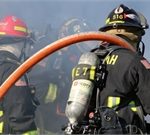Female firefighters are exposed to chemicals that may be linked with breast and other types of cancer, researchers say.
Compared to women working in offices, female firefighters in San Francisco are exposed to higher levels of per- and polyfluoroalkyl substances (PFAS). These chemicals are used in firefighting foam and uniforms, grease- and water-resistant coatings and in fabrics, furniture and food packaging.
PFAS have been linked to a number of cancers and are known to interfere with breast development as well as immune and endocrine function, according to the study published Feb. 26 in the journal Environmental Science and Technology.
It’s one of the first published from the Women Firefighter Biomonitoring Collaborative, a long-term investigation into chemical exposure among female firefighters.
“Women firefighters actually raised concern about what they have perceived as elevated rates of breast cancer among their cohort in San Francisco,” said study lead author Jessica Trowbridge, a doctoral student in the School of Public Health at the University of California, Berkeley.
“As a team, we decided to conduct an exposure study looking at chemicals that are potential breast carcinogens,” Trowbridge said in a university news release.
Studies looking at PFAS-exposure cancer rates among firefighters have primarily focused on men. Assessing the specific risks faced by female firefighters is crucial in ensuring that they have the necessary protections, both for cancer prevention and for compensation if they get sick, the researchers explained.
“This is the first study, to our knowledge, that’s been done on women firefighters,” said study senior author Rachel Morello-Frosch, a professor of environmental science, policy and management at UC Berkeley.
Researchers collected blood samples from 86 female firefighters and 84 women who work in offices in downtown San Francisco. They also interviewed each woman about her workplace activities, eating habits and consumer product use.
Of the 12 types of PFAS chemicals tested, seven were found in detectable amounts in most participants’ blood samples, and four were found at detectable amounts in all participants’ samples.
Three of the seven — PFHxS, PFUnDA and PFNA — were detected at significantly higher amounts in firefighters’ blood than in the office workers’ blood.
In a companion study published online this month in the same journal, the researchers described a new way to screen blood samples quickly for a variety of toxic compounds. The new method could help identify other potentially harmful chemicals that female firefighters might be exposed to, they said.
More information
The U.S. Agency for Toxic Substances and Disease Registry has more on PFAS.
Copyright © 2025 HealthDay. All rights reserved.





-300x169.jpg)










